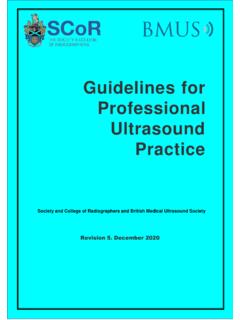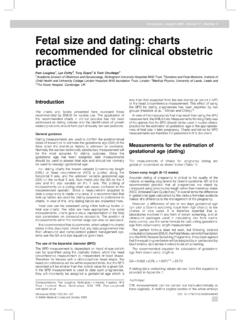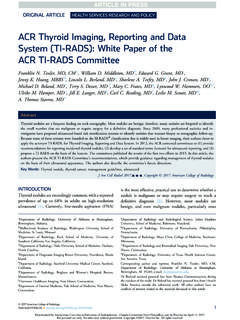Transcription of Renal Ultrasound - bmus.org
1 Renal Ultrasound (Basic Principles) BMUS Study Day Rosie Conlon Clinical Specialist Sonographer NATIONAL REHABILITATION HOSPITAL Dun laoghaire, Dublin Sat 15th October 2016 WHY? Bones can break, muscles can atrophy, glands can loaf about and even the brain can sleep without immediate danger to survival. BUT when the kidneys Neither bone, muscle gland nor brain could carry on. Homer William Smith, The Evolution of the Kidney , Lectures on the Kidney (1943). Renal Ultrasound (Basic Principles) and BMUS Study Case PREPARATION 500mls 1 hour before, avoiding micturition. Catheter clamped hours before. Fluids by PEG hours before. Operator Dependant Real Time Reproducible Non-invasive Inspiration WHAT? - PROTOCOL Both Kidneys Urinary Bladder +/- Residual Volume Pelvic Surveillance Aorta Local protocol pertinent to the population Full bladder The most important step in diagnosis is realising that it might exist.
2 Renal Ultrasound (Basic Principles) and BMUS Study Case RIGHT KIDNEY-TECHNIQUE A MHz probe is typically used to scan the kidney. For the right kidney, have the patient lie supine and place the probe in the right lower intercostal space in the midaxillary line. Use the liver as your acoustic window and aim the probe slightly posteriorly (toward the kidney). Gently rock the probe (up and down or side to side) to scan the entire kidney. If needed, you can have the patient inspire or exhale, which allows for subtle movement of the kidney. Obtain longitudinal (long axis) and transverse (short axis) views. Renal Ultrasound (Basic Principles) and BMUS Study Case ANATOMY Renal Ultrasound (Basic Principles) and BMUS Study Case Celiac axis SMA Renal artery Renal vein Hepatic Veins Right kidney Left kidney Liver Spleen NORMAL Renal Ultrasound (Basic Principles) and BMUS Study Case LEFT KIDNEY-TECHNIQUE For the left kidney have the patient lie supine or in the right lateral decubitus position.
3 Place the probe in the lower intercostal space on the posterior axillary line. The placement will be more cephalad and posterior than when visualizing the right kidney. Again gently rock the probe to scan the entire kidney. Obtain longitudinal and transverse views Renal Ultrasound (Basic Principles) and BMUS Study Case APPROACH TO SCANNING Renal Ultrasound (Basic Principles) and BMUS Study Case Right kidney scanning approach: anterior, lateral, posterior Liver is the acoustic window Left kidney: requires a posterior approach, through the spleen Air-filled bowel impedes anterior scanning I LIVER STOMACH IVC AORTA K K S Renal SCANNING APPROACHES Renal Ultrasound (Basic Principles) and BMUS Study Case NORMAL ANATOMY Renal Ultrasound (Basic Principles) and BMUS Study Case 9-12 cm long, 4-5 cm wide, 3-4 cm thick Gerota s fascia encloses kidney, capsule, perinephric fat Sinus Hilum: vessels, nerves, lymphatics, ureter Pelvis.
4 Major and minor calyces Parenchyma surrounds the sinus Cortex: site of urine formation, contains nephrons Medulla: contains pyramids that pass urine to minor calyces. Columns of Bertin separate pyramids NORMAL ANATOMY Renal Ultrasound (Basic Principles) and BMUS Study Case Renal capsule Cortex Medullary pyramids Minor Calyx Kidney Anatomy Medulla Sinus Major Calyx NORMAL ANATOMY Renal Ultrasound (Basic Principles) and BMUS Study Case Kidneys are retroperitoneal, T12 - L4 Right kidney is lower than the left kidney Right kidney is posterio-inferior to liver & gallbladder Left kidney is inferior-medial to the spleen Adrenal glands are superior, anterior, medial to each kidney THICKENED BLADDER WALL Renal Ultrasound (Basic Principles) and BMUS Study Case BLADDER VOLUME Renal Ultrasound (Basic Principles) and BMUS Study Case Ureteric Jets Renal Ultrasound (Basic Principles)
5 And BMUS Study Case Male Anatomy Prostate Gland Seminal Vesicles OVER-HYDRATION Pre-Micturition Post Micturition Renal Ultrasound (Basic Principles) and BMUS Study Case INTERVENTIONAL VARIANTS Renal Ultrasound (Basic Principles) and BMUS Study Case Dromedary humps: Lateral kidney bulge, same echogenicity as the cortex Hypertrophied column of Bertin: Cortical tissue indents the Renal sinus Double collecting system: Sinus divided by a hypertrophied column of Bertin Horseshoe kidney: Kidneys are connected, usually at the lower pole Renal ectopia: One or both kidneys outside the normal Renal fossa VARIANTS Pelvic Kidney Dromedary Hump Renal Ultrasound (Basic Principles) and BMUS Study Case Renal Ultrasound (Basic Principles) and BMUS Study Case EXTRA Renal PELVIS Extra Renal Pelvis refers to the presence of the Renal pelvis outside the confines of the Renal hilum.
6 It is a normal variant that is found in ~10% of the population . The Renal pelvis is formed by all the major calyces. An exta- Renal pelvis usually appears dilated giving a false indication of an obstructive pathology. CT for clarification. Avoid confusion with hydroureter or PUJ obstruction Renal Ultrasound (Basic Principles) and BMUS Study Case VARIANTS Renal Ultrasound (Basic Principles) and BMUS Study Case HORSESHOE KIDNEY Renal Ultrasound (Basic Principles) and BMUS Study Case CROSS FUSED ECTOPIA Cross fused ectopic kidney. The left kidney is fused to the lower pole of the right kidney Renal Ultrasound (Basic Principles) and BMUS Study Case Renal CYSTS Cyst 1 Cyst 2 Renal Ultrasound (Basic Principles) and BMUS Study Case Renal SCARRING Renal Ultrasound (Basic Principles) and BMUS Study Case MULTICYSTIC DYSPLASTIC KIDNEY Right kidney in a new-born shows no normal Renal parenchyma and the right Renal fossa filled with multiple simple appearing cystic structures c/w MCDK.
7 The cysts did NOT communicate Renal Ultrasound (Basic Principles) and BMUS Study Case ANGIOMYOLIPOMA This is a homogeneous, highly echogenic, usually rounded lesion in the Renal parenchyma containing blood vessels, muscle tissue and fat, as the name suggests. They are usually solitary, asymptomatic lesions, found incidentally , although larger lesions can haemorrhage causing haematuria and pain. Renal Ultrasound (Basic Principles) and BMUS Study Case MULTIPLE ANGIOMYOLIPOMAS Also associated with Tuberose sclerosis, they tend to be multiple and bilateral. Renal Ultrasound (Basic Principles) and BMUS Study Case OBSTRUCTIVE UROPATHY GRADING SYSTEM - SUBJECTIVE Mild Minimal separation of calyces Moderate Dilation of major and minor calyceal system Severe Marked dilation of the Renal pelvis and thinning of the Renal parenchyma Renal Ultrasound (Basic Principles) and BMUS Study Case RANGE OF HYDRONEPHROSIS Renal Ultrasound (Basic Principles) and BMUS Study Case Normal Mild Moderate Severe HYDRONEPHROSIS Renal Ultrasound (Basic Principles) and BMUS Study Case Intrinsic acquired Renal lithiasis Neoplasm ( Renal , ureteral, bladder) Papillary necrosis Ureterocele Blood clot Neurogenic bladder Anticholinergics Pregnancy, PID, uterine prolapse)
8 Diuretics Vesico-ureteral reflux Diabetes insipidus Intrinsic congenital Stenosis (ureteral, urethral, meatal) Adynamic ureter Spinal cord defects Duplication of the ureter Ureterocele HYDRONEPHROSIS Mild Hydronephrosis Renal Ultrasound (Basic Principles) and BMUS Study Case HYDRONEPHROSIS Moderate Hydronephrosis Renal Ultrasound (Basic Principles) and BMUS Study Case SEVERE HYDRONEPHROSIS Renal Ultrasound (Basic Principles) and BMUS Study Case Severe Hydronephrosis SMALL KIDNEYS Unilateral (may be bilateral) Chronic infections RAS Renal Artery Stenosis Hypoplastic Kidney Always bilateral Chronic glomerulonephritis Hypertensive nephropathy Collagen Vascular Disease Renal Ultrasound (Basic Principles) and BMUS Study Case ENLARGED KIDNEYS Always Unilateral Compensatory hypertrophy Bilateral or Unilateral Renal Mass Hydronephrosis Renal vein thromboses Lymphoma Amyloidosis Always Bilateral PCK Polycystic Kidney Disease AGN Acute glomerulonephritis Amyloidosis Renal Ultrasound (Basic Principles) and BMUS Study Case Urolithiasis Renal Calculi- Bladder Calculi U/S only 41 Fig.
9 3 Fig. 4 Fig. 5 Fig. 3, 4 & 5 Bladder stones with posterior shadowing clearly seen at US in distended bladder but not apparent on X-ray. Staghorn Calculus BLADDER DIVERTICULAE Renal Ultrasound (Basic Principles) and BMUS Study Case Diverticula of the bladder in infants and children are common and occur when bladder mucosa protrudes through a congenital defect in the detrusor muscle wall. Most are primary. Those secondary to obstruction or neurogenic dysfunction are less common than previously thought. Renal Ultrasound (Basic Principles) and BMUS Study Case Renal Ultrasound (Basic Principles) and BMUS Study Case BLADDER CALCULI Renal Ultrasound (Basic Principles) and BMUS Study Case Renal MASS Renal Ultrasound (Basic Principles) and BMUS Study Case Pyelonephritis: sonographic appearance is most commonly normal, but you may find hypoechoic cortex and loss of demarcation between the outer cortex and middle pyramids and columns of Bertin.
10 Renal mass: may have any echotexture (hyperechoic, anechoic etc.) and appear anywhere within the kidney Transplant kidney: a normal echotexture kidney, typically in a pelvic location TRANSITIONAL CELL CARCINOMA Ultrasound images Large, transitional cell carcinoma in the upper pole of the RK. The changes are more subtle than those of Renal cell carcinoma, and the Renal outline remains intact. Transitional cell carcinoma is the most common bladder tumour, occurring less frequently in the collecting system of the kidney and the ureter. It usually presents with haematuria while still small. It is best diagnosed with cystoscopy. Renal Ultrasound (Basic Principles) and BMUS Study Case HYDRONEPHROSIS DUE TO TCC URETER Renal Ultrasound (Basic Principles) and BMUS Study Case US AND CT Renal CA Renal Ultrasound (Basic Principles) and BMUS Study Case Renal CELL CARCINOMA Large, heterogeneous mass which enlarges and deforms the shape of the kidney (Fig.)











